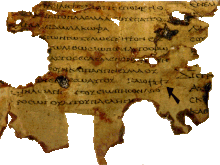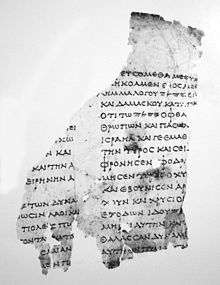Scroll of the Twelve Prophets from Nachal Chever
The Scroll of the Twelve Prophets from Nachal Chever (also 8HevXII gr ) is a Greek manuscript of the Book of the Twelve Prophets from the 1st century, which was found in cave no. 8 in Nachal Chever , a wadi in the Judean Desert near the Dead Sea . It is one of the Dead Sea Scrolls .
Find history

In the course of the documents found at the Dead Sea by Bedouins , a collection of scrolls and fragments was purchased between 1952 and 1954, which, according to the Beduins , should come from the Nachal Ze'elim . The Bedouins sold their finds to researchers in East Jerusalem , which at the time belonged to Jordan , while Wadi Seiyal was part of Israel . The fragments also included parts of a scroll from the Book of the Twelve Prophets (Dodecapropheton). In response, among other things, to rumors that some of the scrolls sold came from Israel, the Hebrew University of Jerusalem sent two expeditions in 1960 and 1961 to thoroughly explore the wadis on the west bank of the Dead Sea. Part of the company's expedition B in the spring of 1961, led by Yohanan Aharoni, examined the caves on the southern edge of the Nachal Chever in particular and found what they were looking for in cave no.8 , the Cave of Horror : fragments of a Greek scroll were found, among other things. The fragments, for the most part only a few centimeters in size, can still be assigned to the Book of the Twelve Prophets. It also became apparent relatively quickly that the fragments were parts of the same scroll that had been purchased ten years earlier. The location of this scroll - like most of the other scrolls in the Seiyâl Collection - was therefore determined to be the Nachal Chever, contrary to the information given by the Bedouins.
The archaeological context could no longer be determined due to the excavations of the Bedouins. However, a layer of burn was found in the cave, which suggests that the last inhabitants of the cave wanted to destroy all their belongings, especially documents that could provide information about other rebels, in order not to fall into the hands of the Romans to let. These besieged the inmates, as a military camp located above the cave shows. That the scroll survived this fire suggests that it was buried earlier. This practice is mainly known from the later Jewish tradition ( Geniza ), but was also observed in the role of the Twelve Prophets from Wadi Murabba'at .
The manuscript is now in the Rockefeller Museum in East Jerusalem.
Dimensions and content
The role is only partially preserved, generally better in the lower part. Only in column 8 are parts of all four margins preserved, of most of the other columns only the lower margin and parts of the right or left margin are preserved. Attempts at reconstruction show that the average number of lines per column is around 42. In the back part, on the other hand, which can be assigned to a different hand, the letters are written larger and therefore the columns only contain 33 lines. The columns had a height of about 27 cm. The column width, on the other hand, varies between 7.5 and 9 cm or 29 and 43 letters, in the rear part even only 22-24 letters. This is obviously related to the width of the individual sheets of leather sewn together to form a roll. While the arches themselves varied in width, the columns appear to have been drawn relatively evenly on an arch. Finally, the height of the roll can be determined at around 35 cm. Calculations on the number of columns depend heavily on the content of the role. Assuming an originally complete book of the Twelve Prophets, the scroll should have comprised between 80 and 94 columns, which would correspond to about 9.6-10 m. The scroll would be longer than all the existing scrolls from Qumran . However, only parts of the books Jona , Micha , Nahum , Habakuk , Zefanja and Zechariah are proven .
Text and scribe
As the differences in letter shape and size show, the handwriting was written by two different scribes. The assumption that instead the fragments should be divided into two different roles is less likely. However, the reason for the different scribes' hands is unclear. Either the scroll was started by one scribe and later finished by a second, or the leather sheets with the second handwriting were inserted for repair.
Several lines are left blank between the individual books, but possible book titles are not attested. The running text is divided into larger and smaller sections, and a division into verses can even be observed. The division into units of meaning largely corresponds to the division of the Masoretic text into Setumot and Petuchot . To identify such sections, either a horizontal line is drawn between the lines - a paragraphos - or the new line begins slightly to the left and with a slightly enlarged initial letter. In the first hand, however, there is usually no space left between individual words of a verse.
A special feature is the rendering of the tetragram : It is entered in the Greek text in ancient Hebrew script . A similar approach can be found in Papyrus Fouad 266 . While there the tetragram was probably added by another hand, in the case of the scroll of the Twelve Prophets from the Nach Chever it can be assumed that the scribe himself continuously inserted the ancient Hebrew letters into the Greek text, probably even against the Hebrew writing direction from left to right!
The fragmentary state of preservation of the text also makes it difficult to make statements about the textual character. However, the editors agree that it is an early revision of the Septuagint (so-called kaige review) in alignment with the Hebrew text.
Time of origin
A more precise determination of the period in which the role was created is difficult. The archaeological context gives the terminus ante quem the year 135 AD, since the Bar Kochba uprising was put down in that year , during which the scroll was probably brought into the cave. A palaeographical determination is helpful for a further limitation , but in the case of Greek manuscripts it has to be reckoned with numerous blurring. However, a dating to the 1st century suggests itself.
literature
- Dominique Barthélemy : Redécouverte d'un chaînon manquant de l'histoire de la Septante. In: Revue Biblique 60 (1953), pp. 18-29.
- Dominique Barthélemy: Les devanciers d'Aquila. Supplements to Vetus Testamentum 10. Leiden 1963.
- Baruch Lifshitz: The Greek Documents from the Cave of Horror. In: Israel Exploration Journal 12 (1962), pp. 201-207, plate 32.
- Emanuel Tov : The Greek Minor Prophets Scroll from Naḥal Ḥever (8ḤevXIIgr) (The Seiyâl Collection I). Discoveries in the Judaean Desert VIII. Oxford 1990. [Reprinted with Corrections 1995]
- Émile Puech : Les fragments non identifiés de 8KhXIIgr et le manuscrit grec des Douze Petits Prophètes. In: Revue Biblique 98 (1991), pp. 161-169.
- Émile Puech: Notes en marge de 8KhXIIgr. In: Revue de Qumran 15 (1992), pp. 583-593.
Individual evidence
- ↑ These fragments were given the preliminary siglum Se2grXII.
- ^ Brook WR Pearson: The Book of the Twelve, Aqiba's Messianic Interpretations, and the Refuge Caves of the Second Jewish War , in: The Scrolls and the Scriptures. Qumran Fifty Years After , ed. By Stanley E. Porter and Craig A. Evans. Journal for the Study of the Pseudepigrapha. Supplement Series 26. Sheffield: Sheffield Academic Press 1997. ISBN 1-85075-844-1 ; Pp. 221-239, esp. 232-235.
